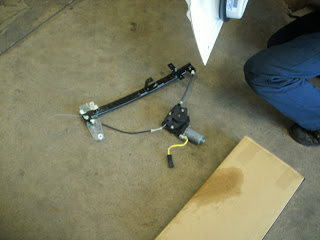 Replacing the window regulator in a 2000 Jeep Grand Cherokee is a fairly straight forward process. Removing the door panel is probably going to be the hardest part of the process as some of the clips can be stubborn and you want to be careful so as not to break any of them. That is Troy to the left removing the door lining so he can get to the hardware.
Replacing the window regulator in a 2000 Jeep Grand Cherokee is a fairly straight forward process. Removing the door panel is probably going to be the hardest part of the process as some of the clips can be stubborn and you want to be careful so as not to break any of them. That is Troy to the left removing the door lining so he can get to the hardware.Once you have the door panel off and the lining removed, you can easily access the nuts and bolts that mount the regulator to the door. On this particular vehicle, the regulator and motor are one assembly. So the cost of the parts are a little higher than if you only had to purchase the regulator. There are only a few bolts holding the regulator in place so once you get the panels and lining off, the job moves along very quickly. Troy did this job in about 30 minutes, but keep in mind that he is a serious tech that takes pride in his work. He has a true passion for what he does and it reflects on every vehicle he touches.
Step by step Instructions:
1. Remove the door panel (3 screws: one in armrest and one near the rear view mirror and last one is a hex head located in the door handle well)
2. Pop door panel off easily using a wide flat tip screw driver or something that’s plastic, thin and wide to prevent scratching… start popping it off at the bottom of the door in a corner

3. Once you get the panel popped out some, you need to disconnect the power window cable, power mirror cable, and door and lock controls so you can completely remove the panel. (cables have a little clip on the back of them, squeeze it to unlock and remove) (Door and lock metal rods have a plastic retainer, gently turn them and then easily pull out of their respective holes)
4. Remove the plastic cover This one had a black plastic cover under the door panel and it was attached with some black rubber like glue. The glue is none drying so if you remove it carefully, a little at a time it will stay on the plastic and you can re-use it.

5. Where the window comes through the top of the door or ...the part that your arm rests on if you hang your arm out the open window....there are 2 rubber seals that the window comes up between when it’s raised. Remove the inner one (towards the inside of the car) you can pry it up and it will pop out. Be sure to save the 2 sponge looking things that are under each end if your model has them.
6. Take out the 2 clips that hold the window to the regulator. You will have to reach inside the door and pull them out, one on the left and right...no problem.
7. Window removal: Once you have removed the clips holding the window to the regulator you have to gently work the two window “nipples” out of the regulator holes. Once you have it up a little past the regulator window holding piece…turn the window so that the rear of it is up and comes out first….then work it upwards to remove it from the door. It should come out easily, if not take a break because you don’t want to buy glass too.
8. Unplug the power window cable from the window motor (located in the center of the door)
9. Remove screws th
 at hold the regulator and the window motor to the inside of the door (I think there were 4 regulator screws and 3 holding the motor, they are different sizes) they are the only screws left.
at hold the regulator and the window motor to the inside of the door (I think there were 4 regulator screws and 3 holding the motor, they are different sizes) they are the only screws left.10. Push the window motor cable inside the door, then tilt the entire unit from it’s up and down position to a horizontal left-right position.Then patiently feed it through the hole at the bottom right side of the door…under the hole where the speaker used to be.
11. Once out remove 2 screws? (I can’t remember but you will see) to remove the window motor from the regulator. Clean off the surface of the window motor and attach it to the new regulator.
 This is not really a very complicated job, but it will require a little patience. Notice the old regulator to the left. It doesn't really look like much but this piece, when broken can cause a mountain of headaches. Though most regulators can be purchased without the motor, this one for the Jeep Cherokee can not. You must purchase this as one unit, and depending on where you buy your parts, it can be a little pricey.
This is not really a very complicated job, but it will require a little patience. Notice the old regulator to the left. It doesn't really look like much but this piece, when broken can cause a mountain of headaches. Though most regulators can be purchased without the motor, this one for the Jeep Cherokee can not. You must purchase this as one unit, and depending on where you buy your parts, it can be a little pricey.

